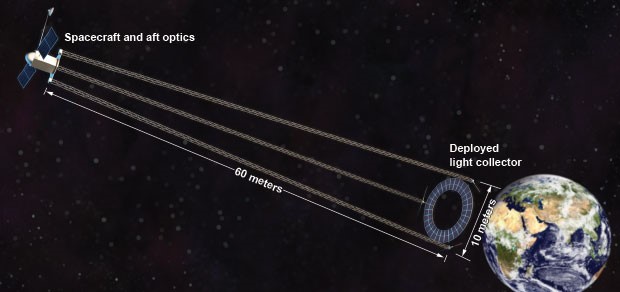Astonishingly enough, the world's most advanced spy and military agencies don’t have space telescopes capable of delivering real-time images and video from anywhere on the globe.


While spy satellites have been around for decades, the cost of manufacturing and launching a system that could carry large precision optics to the 36,000 km (22,369 mi) orbit have kept the dream of consistent surveillance a fantasy. If DARPA has anything to say about it, however, a system that provides nearly limitless space surveillance capabilities may be up and running sooner than you think.
Named MOIRE (MEMBRANE OPTIC IMAGER REAL-TIME EXPLOITATION), DARPA’s answer to consistent surveillance is a two-phase program which began in March of 2010. According to DARPA, “[t]he MOIRE program seeks to develop the enabling technologies required for very large optic space platforms that reduce the areal density (the mass of the optics compared to the size of the spacecraft) by 4-5 times of current systems.“
Beyond that goal, “The program aims to examine technologies for manufacturing large membranes (up to 20 meters), large structures to hold the optics flat, and also demonstrate the secondary optical elements needed to turn a diffraction-based optic into a wide bandwidth imaging device.”

Since 2010, MOIRE has moved through its first phase - where a proof of concept was created - and into phase two where manufacturing is set to begin. As part of its second phase, engineers at Ball Aerospace & Technology have developed a prototype of a five-meter wide optic and its complimentary sensor systems. Both components will be sent to space aboard the Air Force Academy’s FalconSAT-7 program sometime in the near future.
For the time being, Ball’s designs have only been verified through ground-based tests, however, the results look promising for the future of the system. “The ground demonstration substantiates that this innovative technology could work on next generation space telescopes to greatly reduce their costs and enable larger telescopes," said Ball Aerospace President Rob Strain. "This technology could apply to a wide-range of applications providing various forms of information to a multitude of users."
While many may feel uncomfortable with the idea of real-time, undetectable surveillance, it appears the engineers at DARPA don’t share those concerns and are quickly moving forward with this advanced spy-satellite.
Image and Video Courtesy of Softpedia & DARPA
No comments:
Post a Comment